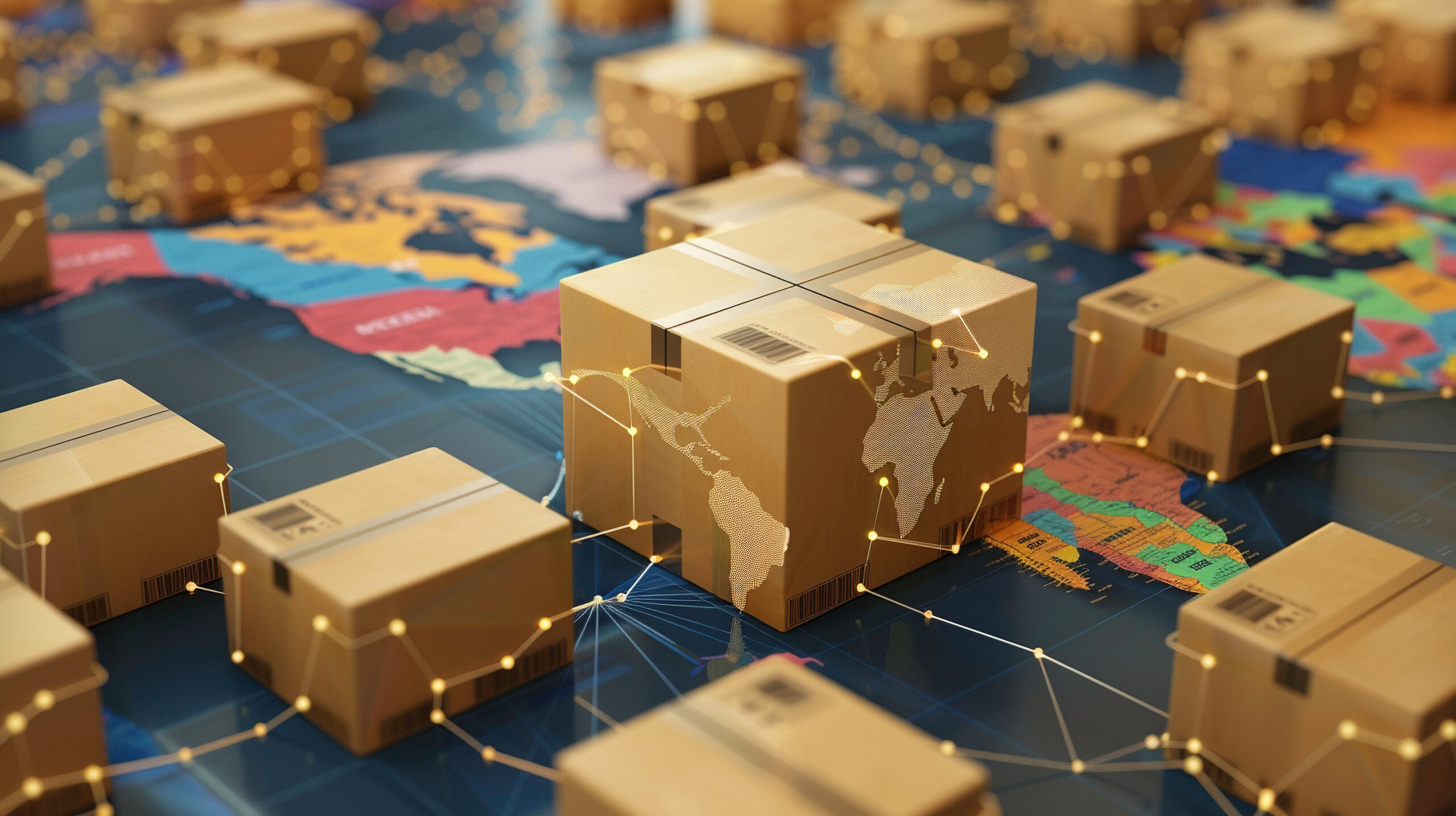Introduction
Modern supply chains are vast, dynamic, and fragmented, spanning multiple regions, suppliers, and modes of transportation. This complexity enables global commerce at scale but also increases exposure to internal and external risks that can disrupt operations, delay deliveries, and impact profitability.
That’s where managing supply chain risk becomes essential.
According to McKinsey & Company, companies can expect to lose nearly 45% of one year’s profits over the course of a decade due to supply chain disruptions. These shocks—from raw material shortages to geopolitical volatility—are becoming more frequent and severe across industries. That makes having a digitally enabled, real-time supply chain risk management plan not just strategic, but essential.
Supply chain risk management (SCRM) is the strategic process of identifying, assessing, and mitigating risks throughout the supply chain. These risks might include natural disasters, geopolitical instability, supplier bankruptcy, cyberattacks, or compliance issues. Without a proactive risk mitigation strategy in place, even small disruptions can have a cascading effect.
In this article, we explore six key reasons why every business needs a supply chain risk management plan—and how it can protect your operations, your bottom line, and your brand.

Reason #1: Minimize Disruptions
Disruptions are inevitable. The question is whether you’re prepared when they hit.
From wildfires and port strikes to pandemics and geopolitical conflicts, supply chains today face constant threats. A comprehensive risk mitigation plan enables businesses to anticipate and prepare for these events before they escalate into full-blown crises.
Common supply chain disruptions include:
- Natural disasters: floods, hurricanes, earthquakes
- Geopolitical events: trade disputes, sanctions, war
- Logistics failures: port congestion, transportation breakdowns
- Supplier issues: insolvencies, delivery delays, quality defects
Without a plan, even minor hiccups can ripple across your supply chain management, delaying production and disappointing customers.
A solid SCRM strategy enables you to:
- Map your entire supply chain to uncover critical vulnerabilities
- Establish alternate suppliers, routes, and inventory strategies
- Respond quickly with pre-defined mitigation plans
The Suez Canal Blockage (2021)
In March 2021, the Ever Given, a 400-meter-long container ship, ran aground in the Suez Canal during high winds and poor visibility—blocking one of the world’s busiest trade arteries for six full days and halting nearly 12% of global trade.
The impact was staggering:
- Lloyd’s List estimated the blockage held up $9.6 billion of trade per day, or about $6.7 million per minute
- Over 400 ships were delayed, carrying everything from electronics to livestock
- Braemar ACM reported that vessel rental costs spiked 47% to $2.2 million due to vessel shortages and urgent rerouting
Companies without a supply chain risk management plan were forced to scramble, facing massive delays and added costs. Those with contingency plans, diversified routes, and real-time tracking systems managed to respond quickly and avoid lasting damage.
Reason #2: Protect Revenue and Profit Margins
Every supply chain disruption has a price tag—whether it’s delayed shipments, unfulfilled orders, or surging freight costs.
Financial risks from supply chain disruptions include:
- Increased operational costs
- Revenue loss due to stockouts
- Penalties from missed SLAs or contractual obligations
- Market share erosion from dissatisfied customers
An effective risk management plan helps you protect your margins by:
- Prioritizing high-risk suppliers and products
- Leveraging real-time cost analytics
- Making agile decisions when unexpected costs arise
Using analytics to avoid losses
Imagine a global consumer electronics company sourcing components from five countries and shipping to 70+ markets. In the past, delays at key ports or material price spikes caught the company off guard, leading to stockouts and costly air freight.
To stay ahead, they implemented a predictive supply chain risk management platform that integrated weather data, geopolitical signals, and supplier performance metrics. As a result, they could:
- Preemptively reroute shipments to avoid bottlenecks
- Adjust production plans around supplier disruptions
- Reduce expedited freight costs through better planning
In some industries, even a brief delay can trigger missed retailer windows, out-of-stock penalties, or chargebacks, turning an avoidable supply chain hiccup into a margin-eroding event. Risk-aware companies protect not just revenue, but customer loyalty and long-term market position.
This mirrors McKinsey’s concept of “resilience by design” and aligns with Harvard Business Review’s research that companies investing in operational agility during crises outperform competitors in the long term.
Reason #3: Enhance Supplier and Vendor Relationships
Strong supplier relationships are the backbone of any resilient supply chain—but they’re only as effective as the communication, transparency, and trust behind them. Without clear expectations and shared visibility into potential and/or known risks, even the most reliable vendors can become points of failure.
That’s where supply chain risk management plays a transformative role.
A collaborative risk management approach doesn’t just protect your business—it strengthens the entire supplier ecosystem by fostering long-term alignment, accountability, and agility.
Here are a few critical ways this approach delivers lasting value:
- Build mutual trust through shared risk assessment: Proactively identifying and discussing potential threats with suppliers, whether it’s a geopolitical disruption or a capacity constraint, demonstrates transparency and builds confidence on both sides of the partnership.
- Develop joint contingency and response plans: When suppliers are part of your risk planning process, you can co-create mitigation strategies, such as alternative sourcing arrangements, safety stock agreements, or capacity ramp-up protocols during peak demand. This helps reduce friction when disruption strikes.
- Monitor supplier performance to flag issues early: Continuous monitoring of on-time delivery rates, lead time variability, or defect trends allows businesses to detect red flags before they escalate—and gives suppliers a chance to course-correct proactively.
When suppliers feel like partners rather than transactional vendors, they’re more likely to prioritize your business, share critical insights, and collaborate during challenging periods.
In today’s volatile environment, reliable supply chains start with reliable relationships, and supply chain risk management provides the structure to maintain them.
According to a 2022 McKinsey report, companies that collaborated closely with their tier-one and tier-two suppliers during the pandemic were 2.5x more likely to avoid severe supply disruptions compared to those that didn’t. Shared contingency planning and real-time communication made the difference.
In short, risk management isn’t just about preventing disruptions—it’s about strengthening the human and operational bonds that keep your supply chain moving, even under pressure.

Reason #4: Compliance with Regulatory Requirements
Regulations are constantly evolving, and non-compliance can cost your business in more ways than one.
Key regulatory pressures include:
- Environmental standards (carbon footprint, emissions tracking)
- Labor and human rights laws (fair wages, ethical sourcing)
- Trade laws and tariffs
- Data security and privacy (especially in logistics tech)
Risk management ensures your supply chain stays ahead of compliance challenges by:
- Mapping regulation-sensitive suppliers and regions
- Automating compliance documentation
- Flagging policy changes and geopolitical risks in real time
The European Union’s Corporate Sustainability Due Diligence Directive (CSDDD) will require companies to identify and address adverse human rights and environmental impacts in their global value chains. Without proper risk management, non-compliance could lead to fines and reputational damage.
Another key example is the Uyghur Forced Labor Prevention Act (UFLPA) in the United States, which prohibits the import of goods produced in China’s Xinjiang region unless companies can prove, through auditable records, that no forced labor was involved. This has prompted a surge in demand for real-time traceability, end-to-end supplier visibility, and digital chain-of-custody tools.
Regulatory expectations are also tightening around climate-related disclosures. Initiatives like the SEC’s proposed climate risk rule and the EU’s CSRD are pushing companies to measure and report emissions across their full supply chain, making upstream traceability more than just a “nice-to-have.”
With growing ESG expectations from investors and consumers alike, companies that proactively integrate regulatory compliance into their risk management plans not only avoid penalties but they build trust and brand resilience.
Reason #5: Improve Operational Efficiency
Supply chain risk management isn’t just about defense—it’s about performance.
Identifying risks often uncovers inefficiencies such as:
- Bottlenecks in distribution channels
- Overdependence on a single supplier or region
- Inadequate inventory planning
By addressing these vulnerabilities, companies can:
- Optimize inventory buffers without overstocking
- Balance cost and resiliency
- Use predictive analytics to anticipate demand and align capacity
Tech Advantage: Tools like Trackonomy’s SmartTape and real-time visibility platforms give teams the insight needed to act fast, prevent disruptions, and streamline supply chain operations.
Case Study: Cisco Boosts Efficiency Through Proactive Risk Management
In the aftermath of the 2011 Japan earthquake and tsunami, Cisco Systems activated its global supply chain risk management protocols within 30 minutes of the event. The company quickly identified over 300 affected suppliers and hundreds of impacted components.
To reduce future operational risk, Cisco strengthened its business continuity planning (BCP), mapped supplier dependencies, and developed a Resiliency Index to evaluate and prioritize risks across the supply chain. These efforts allowed Cisco to minimize downtime, maintain service levels, and recover faster than competitors.
By embedding risk insights into supplier selection, product design, and logistics planning, Cisco not only enhanced resilience but also improved operational efficiency, reduced lead times, and avoided costly disruptions.
Reason #6: Build Long-Term Resilience
Resilient supply chains don’t just bounce back—they evolve to handle whatever comes next.
A comprehensive risk management plan empowers businesses to:
- Respond quickly to unexpected shocks
- Learn from disruptions to improve future responses
- Invest in digital tools and data infrastructure to stay agile
Businesses that invest in resilience emerge stronger from crises, better able to seize market share while competitors scramble to recover. In many cases, the ability to maintain operations through disruption becomes a long-term differentiator in competitive industries.
Tech Advantage: Tools like Trackonomy’s SmartTape and real-time visibility platforms give operations teams the insight needed to act fast, prevent disruptions, and streamline workflows, laying the groundwork for measurable efficiency gains.
Case Study: UPS and Trackonomy’s Journey During COVID-19
At the height of the COVID-19 pandemic, the global logistics system faced an unprecedented challenge: delivering millions of temperature-sensitive vaccine doses safely and efficiently amid widespread uncertainty, supply shortages, and over 100,000 reported infections per day. Timely and secure vaccine delivery wasn’t just a logistics goal—it was a matter of global public health.
UPS Healthcare, one of the world’s leading logistics providers, recognized that traditional tools were not sufficient to manage such a high-stakes, high-volume operation. To proactively mitigate risk factors, UPS partnered with Trackonomy to integrate real-time intelligence into its cold chain network.
Trackonomy deployed its smart tape solution and real-time visibility platform to support over 20+ healthcare customers, each managing 1,500+ vaccine shipments daily. To meet demand, Trackonomy scaled its operations 20x in just six months—a testament to the agility of its platform and the urgency of the mission.
Key outcomes of the Trackonomy–UPS partnership:
- 99.9% On-Time Delivery: Smart Tape-enabled shipments provided temperature, humidity, light, and tamper detection in real time, enabling preemptive intervention before doses fell out of spec. The result: vaccine deliveries arrived safely and on time across the globe.
- Enhanced Cold Chain Management: Trackonomy’s environmental monitoring ensured vaccine doses stayed within strict temperature ranges from origin to administration, preserving efficacy and preventing spoilage.
- Improved Visibility and Transparency: Real-time geolocation tracking offered end-to-end visibility throughout the vaccine supply chain, helping UPS manage route planning, accountability, and service-level assurance with unmatched precision.
- Efficient Inventory Management: Predictive analytics helped optimize inventory flow, minimize stockouts, and reduce vaccine wastage, critical during a time of limited global supply.
- Secure Traceability with Liquid Computing: Trackonomy’s “liquid computing” layer enabled digital traceability of each vaccine dose, ensuring authenticity and mitigating risks of counterfeiting or unauthorized diversion.
This collaboration proved that innovative risk management doesn’t just prevent problems—it can actively drive performance. UPS and Trackonomy’s partnership ensured that critical vaccine shipments reached their destinations safely, efficiently, and transparently, setting a new standard for public health logistics.
Conclusion

In an unpredictable world, your supply chain shouldn’t be flying blind. From minimizing costly disruptions to maintaining compliance and building strong supplier relationships, a well-defined plan is your foundation for supply chain resilience and growth.
Whether you’re a global enterprise or a growing brand, risk management isn’t just about surviving—it’s about thriving.
Ready to Take Control of Supply Chain Risk?
Whether you’re building your first risk management strategy or scaling one globally, Trackonomy’s real-time visibility solutions can help you act faster, operate smarter, and stay ahead of disruptions.
Explore how Trackonomy can help you optimize, secure, and future-proof your supply chain.